About the conduction of action potential
The action potential moves on nerve fibers.?This is conduction.
First of all, how thick is the nerve fiber??In mammalian nerves, it is 0.5 to 20 microns (=micrometer).
Here, I will organize the units of length.
One micron is one thousandth of a millimeter, the?same as?one?micrometer?.?Symbol μ
1μ=1μm=10(-/)6m=10(-/)3mm.?At the International Conference of Weights and Measures in 1967, the name "micron" and the symbol "μ" were abolished, and it was changed from October 1997 to use "1 μm" (micrometer) instead of "1 μ".
Japanese over 25 years of age, there is familiar to the micron, the examples of the?object with micron?unit?are red blood cells?and?white blood cells, diameter of which?is a few microns.
Nerve axon thickness and spider silk
a is a spider silk and b is a nerve axon.?The spider thread is 5 to 15 μm and the?nerve is 0.5 to 20 μm, which is almost the same as the spider silk.。
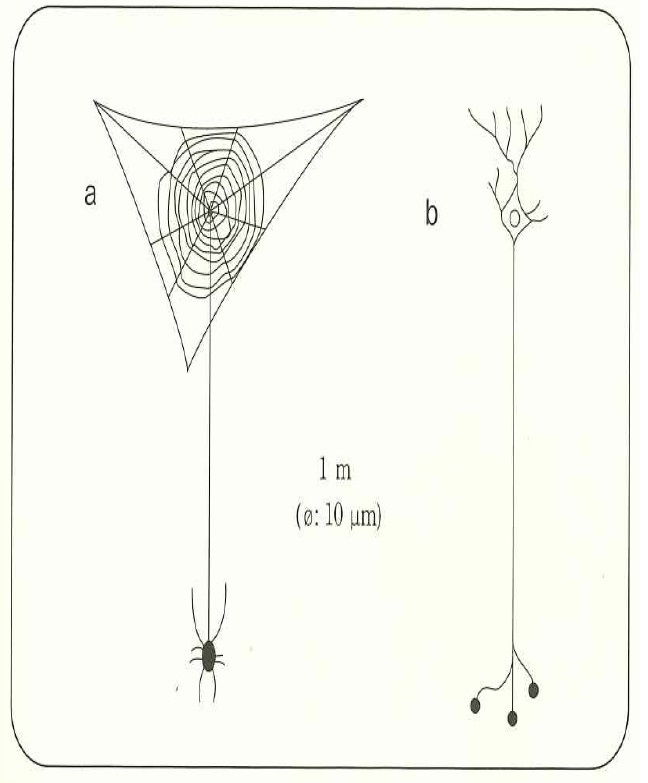
There are many opinions on how the action potential travels down the axon.
Mainly, there are two theories .
One is?the idea that?current is flowing in?the?axon (local current)?. When the potential change caused by the local current around the excitatory site exceeds the threshold of the voltage-dependent Na ion channel in that part, the Na ion channel opens and Na ions flow into the cell, and new an action potential is generated. |
Here I tell you the important point.?The local current generated in the cell is the flow of ions, not electrons.?The electric current represents the movement of electric charge, and it does not have to be an electron.?In physiology, the electric current in the body is the movement of electric charges caused by the movement of ions, not electrons.?In high school, you might learn the word "activity current" , which is a mistake.
Considering the electric current is the movement of free electrons and electric circuits existing in metallic substances, you might think it weird that the electric current is the movement of electric charge generated by a medium other than electrons in the body.
The other is the idea that no current flows in the axon. Based on the pulse theory, the positive ion wave, that is, the depolarization wave propagates far without the movement of the ion itself, causes depolarization in the nearby area, and opens the Na ion channel. |
In a certain area, depolarization opens the voltage-gated Na ion channel, and Na ions diffuse into the cell.?The injected positively charged Na ions push the nearby positive ions around by electrostatic repulsion, and at the same time attract nearby anions.?It causes a positive charge wave, as described above.
Which idea is right now? The majority seem to think that there is an electric current in the axon. Is that true?
Please visit following site. The title is "The Real Story of Jumping Conduction".The theory of "no current" is shown here https://nori-take.wixsite.com/choyaku2013
In addition, it is described in Wikipedia action potential conduction is "the depolarization wave propagates to a long distance without the movement of the ions themselves", and it means that the current does not flow.Please check the site https://ja.wikipedia.org/wiki/%E6%B4%BB%E5%8B%95%E9%9B%BB%E4%BD%8D
Well then First, I will explain how the action potential is transmitted in line with the idea that electricity is flowing. (I'm not very confident in explaining well though.)
In the figure below, the yellow arrow applies a stimulus to the cell membrane. Depolarization by this stimulus opens voltage-gated Na ion channels. Na ions flow in from the outside of the cell, and a large amount of cations are concentrated inside the cell membrane, as indicated by +. Here, the action potential is created. Then proceed to repolarization as usual.
During this time, these cations are attracted or moved to the anion on the right side, and the charge state at that place becomes positive, and the second voltage-gated Na ion channel opens, which means that the action potential has moved.
In the animation below,You can see how positive ions moved to the right.?
When the first action potential begins to fall and reaches the threshold for opening the channel,the second voltage-gated Na ion channel from the left opens,and Na ion flows in .
(Note) The positive and negative changes inside and outside the cell membrane shown in the animation represent the electric charge of the ion, not the electric potential.
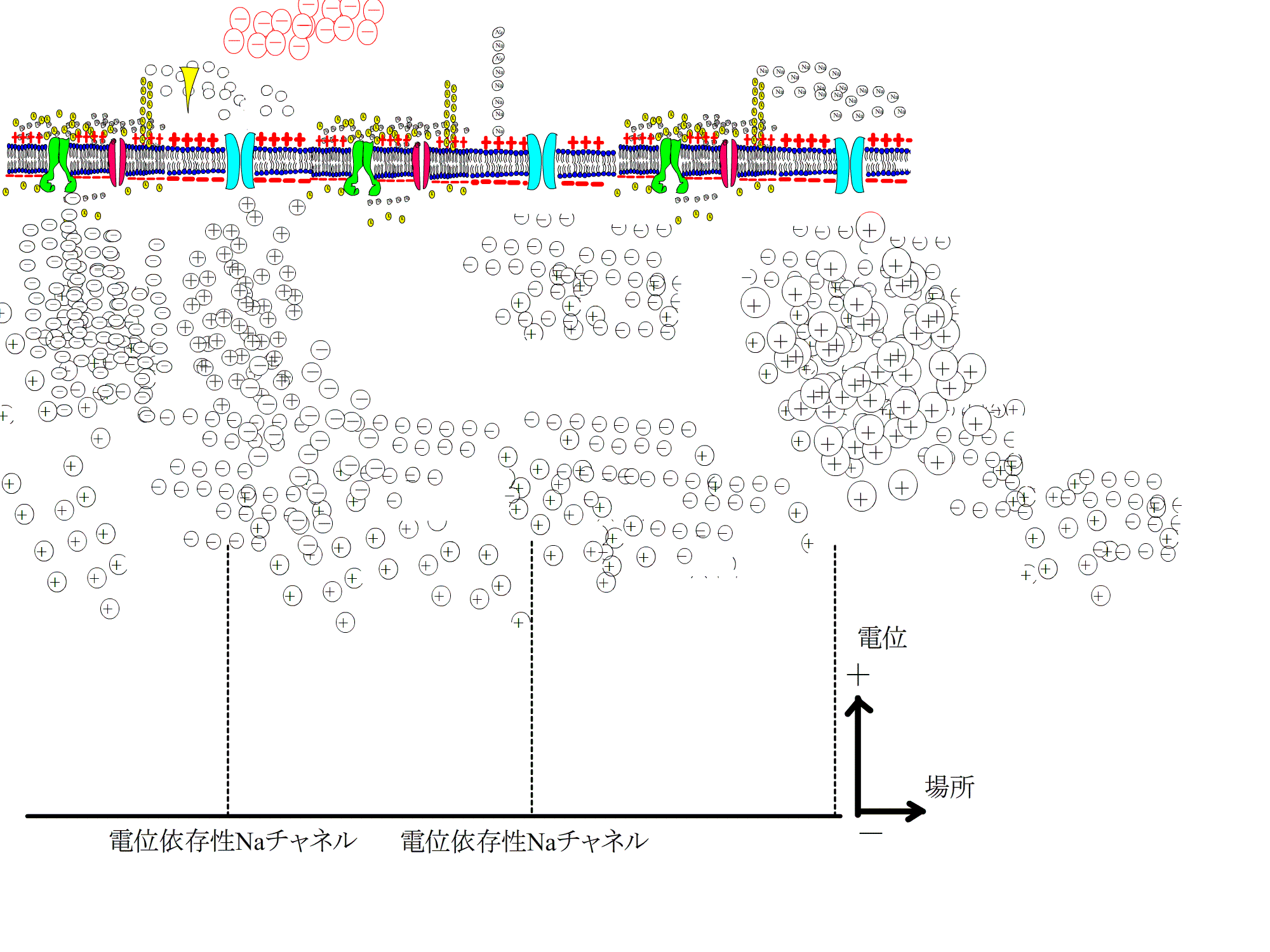
Here I show you a text that organizes these phenomena. "Electrical phenomenon of neurons by Masaki Sakai" . This text shows that current flows in the axon.
In the action potentials shown previously, the horizontal axis represents time and the vertical axis represents potential. In the change described above, the horizontal axis is the location and the vertical axis is the potential. Keep this difference in mind.
Next, Let's see the theory that no current flows.
See the figure below. See from the story of Mr. Shinotake.。
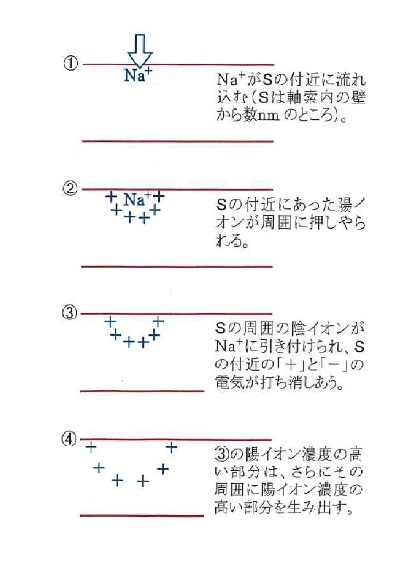
The red line represents the cell membrane, and S is the place where Na ions flow.
According to Mr. Shinotake, the inflowing Na ions push away the surrounding cations by repelling, the waves rise and the electric potential is transmitted. At this time, the Na ion in S does not move, but a wave of Na ion with a higher potential is generated.
If the Na ion in S moves in the direction away from S, the electric charge of the ion will move, which is the same as the current folowing.
In the explanation below, the change in the water surface will be the change in the electric potential.?Na ions do not move as the leaves do not.

Then, I show this conduction state with animation. The white circle is Na ion. The red circles outside the cells are negative ions. The extracellular movement is difficult to be shown here.
The plus and minus signs inside and outside the cell membrane represent the charge of the ions. The level of potential is not show.
If you want to learn more, please visit Shinotake's site.
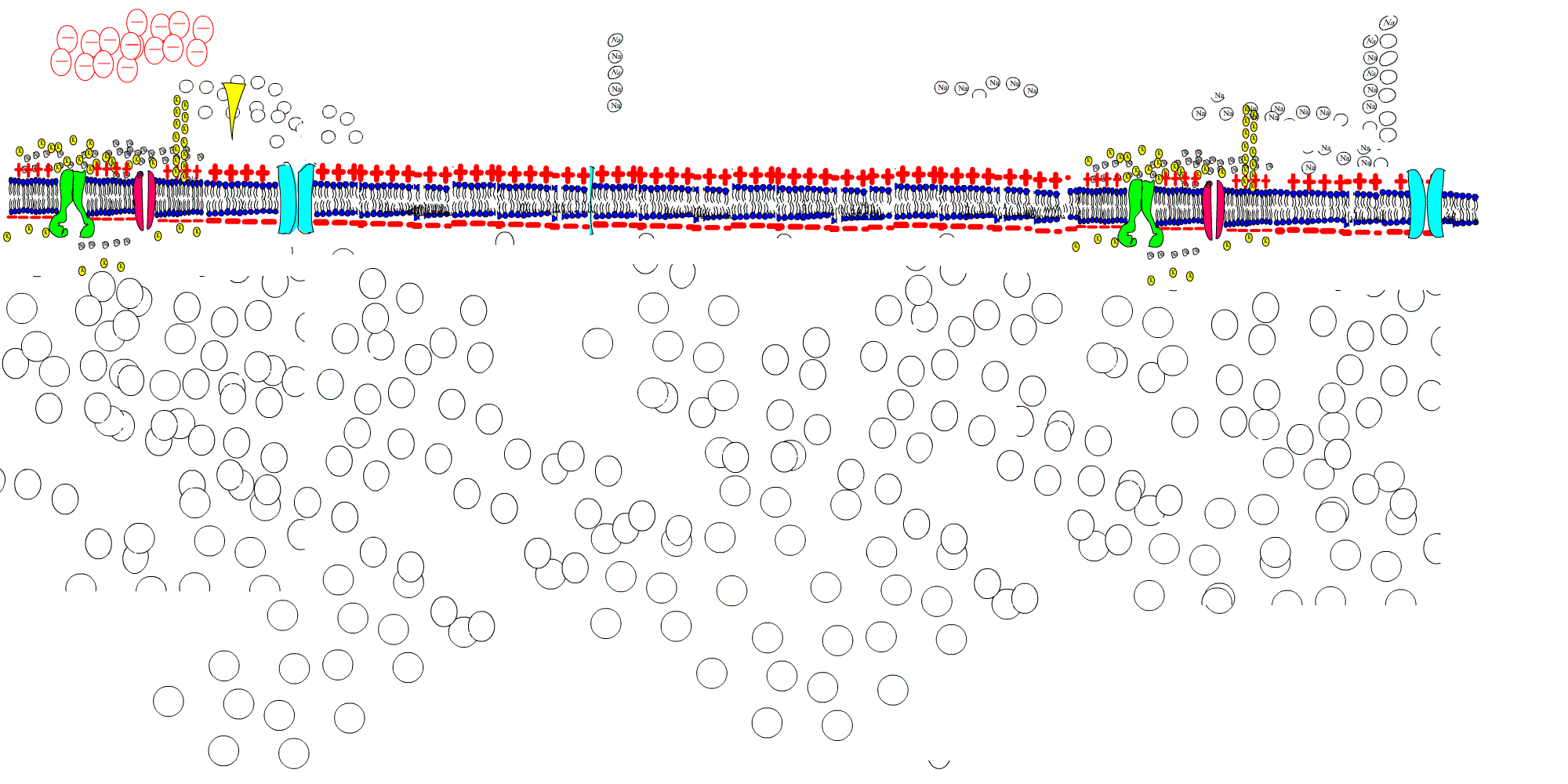
What we see next is saltatory conduction. ?Saltatory conduction is a method of conduction that exists only in the?medullated nerve.
Let's study the difference between unmedullated and ?medullated nerve and the difference between peripheral nerves and central nerves.
The central nerves are oligodendrocytes and the peripheral nerves are Schwann cells, which surround the axon in multiple layers. The surrounding cylindrical sheath is called the myelin sheath. The myelin sheath has a high content of cholesterol and therefore has high electrical insulation.
The central nerves, and peripheral nerves except post-ganglionic fibers and forsensory nerves (pain sensation) have the myelin sheath.
Normal structure and function of human body Cited from nervous system (1)VII
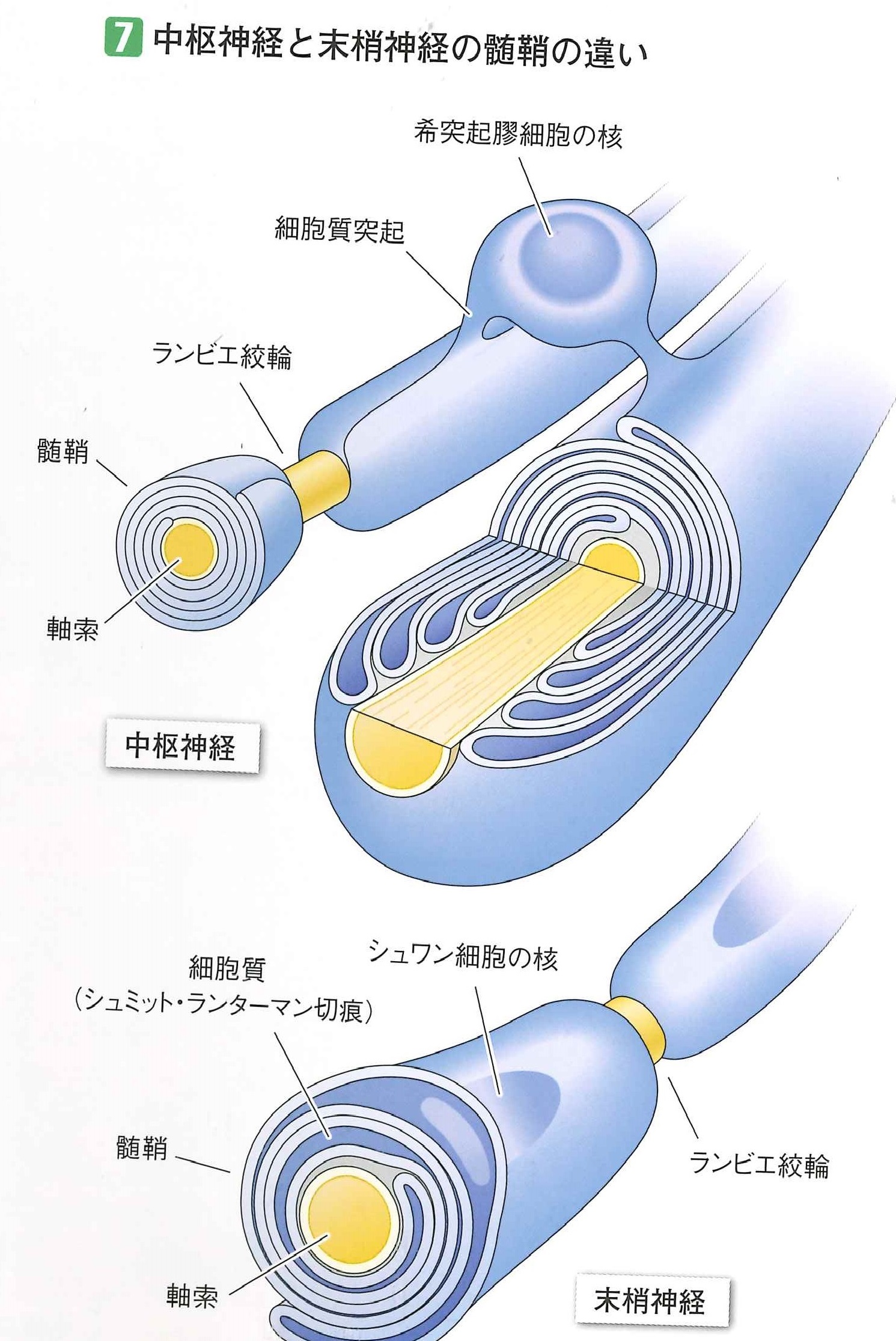
In the central nervous system, one oligodendrocyte surrounds several axons. In the peripheral nerve, one Schwann cell encloses one axon.
Ranvier's node
The myelin sheath is not continuous over the entire length of the axon and is divided into nodes with a length of 1 to 2 mm. The Ranvier's node is this gap,and has no sheath .
axons around Ranvier's node is thicker than the axon covered in the myelin sheath, and the cell membrane around it is rich in Na ion channels.
In the ranvier's node of the central nervous system , the axons are naked. In the one of peripheral nerves, some of the cytoplasm of Schwann cells remains,and there is also a loose-shaped myelin sheath, called the Schmidt‐Lanterman notch.
Those without a myelin sheath are called unmyelinated nerves. As shown in the picture below, Schwann cells wrap around a few axons, but it doesn't form the myelin sheath.
The post-ganglionic fibers and sensory nerves (pain sensation) are unmedullated nerve.
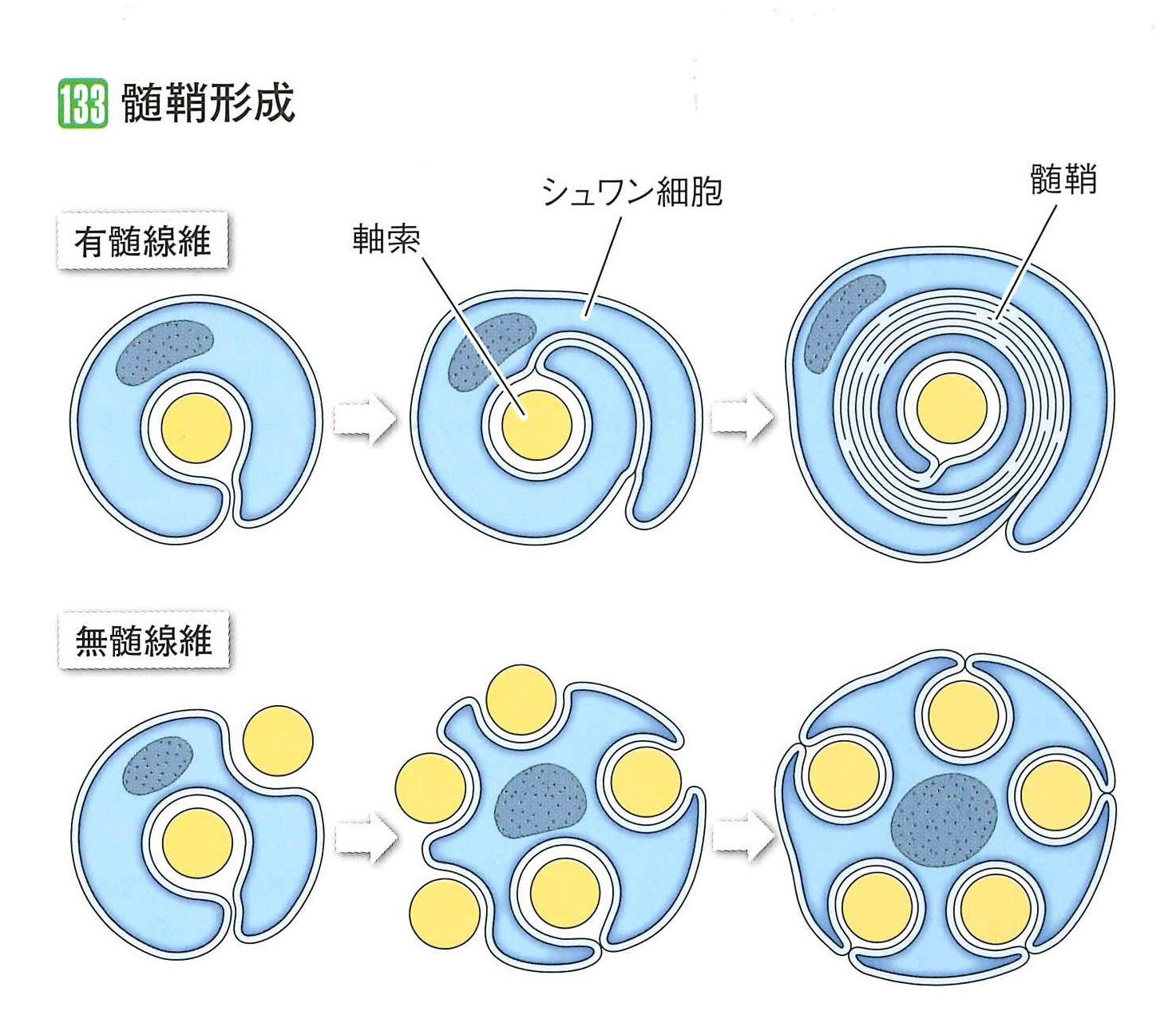
The conduction velocity varies depending on the thickness of the axon and the existence of a myelin sheath .
The thicker the axon, the faster the transmission speed.
Diameter (um)X6 = conduction velocity m/sec)
Naturally, the nerve with myelin sheath has a faster conduction velocity than the unmyelinated nerve.
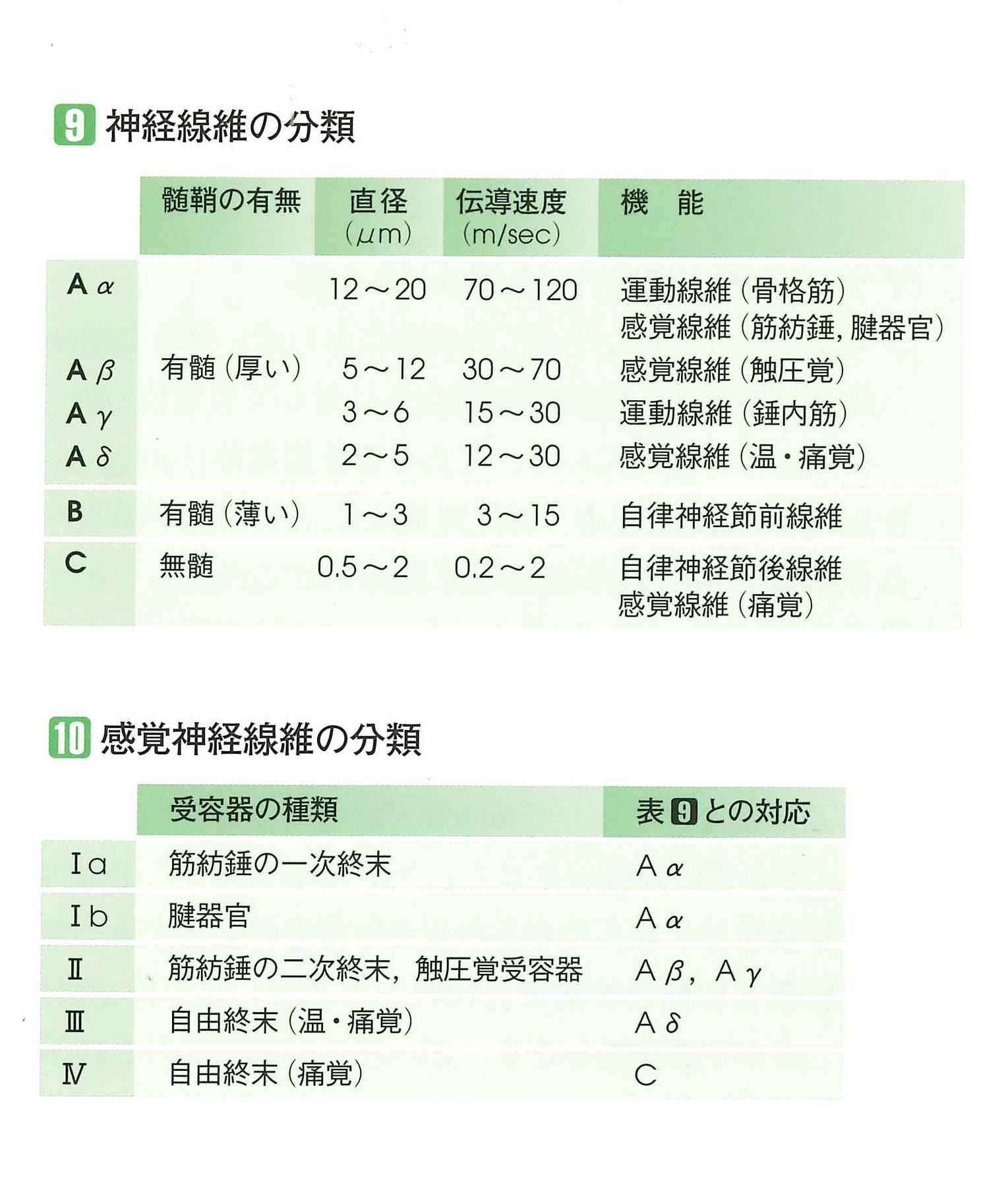
What is?saltatory conduction?
It is a mechanism in which the action potential "jumps" the axons of neurons, thereby suppressing energy loss and quickly transmitting information.
Why is the ?saltatory conduction of the medullated nerve faster than the unmedullated nerve?
| According to the idea that current is flowing in the axon (local current), |
The local electric current hardly flows out of the cell in the part where the sheath is wound, and the local electric potential can maintain a large value further.
| According to the idea that no current flows in the axon, |
You can see it on the "Science network (for public)" page of the Japan Science and Technology Agency. https://rika-net.com/search.php?sc=0&keyword=%E7%84%A1%E9%AB%84%E7%A5%9E%E7%B5%8C
The animation of this site would be nice to learn saltatory conduction mechanism .
The larger the interval between excitable parts and the more "time-consuming sequence", that is, the fewer the sequence of processes in which the Na ion channel opens and Na ions flow into the axon, the smaller the pause in conduction. It makes the conduction velocity faster because the number of high potentials will be transmitted as waves.
postscript
I think that various scholars have similar ideas about the formation of the membrane potential and action potential, but there seem to be different ideas about the mechanism of action potential conduction. Opinions seem to be divided depending on whether current (the flow of ionic charges) is flowing in the axon. This is deep content,though I hope you get the gist.

